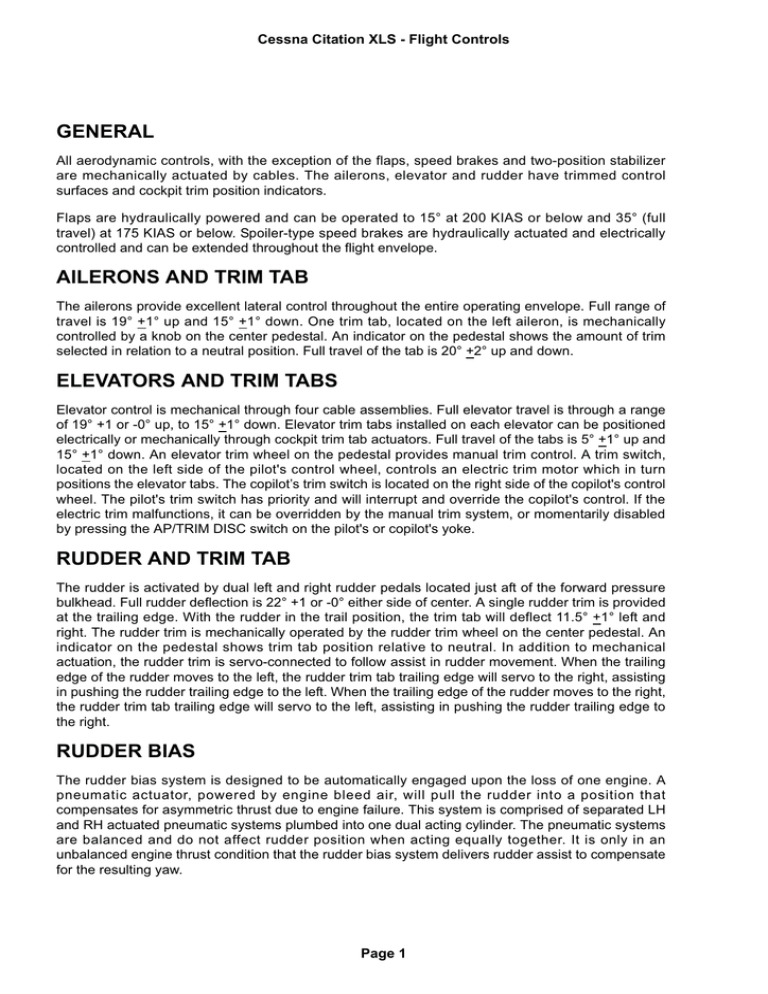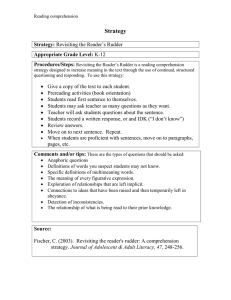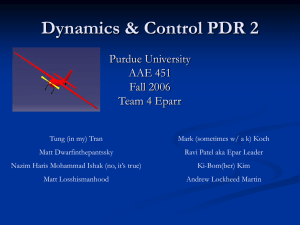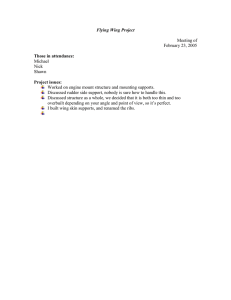general ailerons and trim tab elevators
advertisement

Cessna Citation XLS - Flight Controls GENERAL All aerodynamic controls, with the exception of the flaps, speed brakes and two-position stabilizer are mechanically actuated by cables. The ailerons, elevator and rudder have trimmed control surfaces and cockpit trim position indicators. Flaps are hydraulically powered and can be operated to 15° at 200 KIAS or below and 35° (full travel) at 175 KIAS or below. Spoiler-type speed brakes are hydraulically actuated and electrically controlled and can be extended throughout the flight envelope. AILERONS AND TRIM TAB The ailerons provide excellent lateral control throughout the entire operating envelope. Full range of travel is 19° +1° up and 15° +1° down. One trim tab, located on the left aileron, is mechanically controlled by a knob on the center pedestal. An indicator on the pedestal shows the amount of trim selected in relation to a neutral position. Full travel of the tab is 20° +2° up and down. ELEVATORS AND TRIM TABS Elevator control is mechanical through four cable assemblies. Full elevator travel is through a range of 19° +1 or -0° up, to 15° +1° down. Elevator trim tabs installed on each elevator can be positioned electrically or mechanically through cockpit trim tab actuators. Full travel of the tabs is 5° +1° up and 15° +1° down. An elevator trim wheel on the pedestal provides manual trim control. A trim switch, located on the left side of the pilot's control wheel, controls an electric trim motor which in turn positions the elevator tabs. The copilot’s trim switch is located on the right side of the copilot's control wheel. The pilot's trim switch has priority and will interrupt and override the copilot's control. If the electric trim malfunctions, it can be overridden by the manual trim system, or momentarily disabled by pressing the AP/TRIM DISC switch on the pilot's or copilot's yoke. RUDDER AND TRIM TAB The rudder is activated by dual left and right rudder pedals located just aft of the forward pressure bulkhead. Full rudder deflection is 22° +1 or -0° either side of center. A single rudder trim is provided at the trailing edge. With the rudder in the trail position, the trim tab will deflect 11.5° +1° left and right. The rudder trim is mechanically operated by the rudder trim wheel on the center pedestal. An indicator on the pedestal shows trim tab position relative to neutral. In addition to mechanical actuation, the rudder trim is servo-connected to follow assist in rudder movement. When the trailing edge of the rudder moves to the left, the rudder trim tab trailing edge will servo to the right, assisting in pushing the rudder trailing edge to the left. When the trailing edge of the rudder moves to the right, the rudder trim tab trailing edge will servo to the left, assisting in pushing the rudder trailing edge to the right. RUDDER BIAS The rudder bias system is designed to be automatically engaged upon the loss of one engine. A pneumatic actuator, powered by engine bleed air, will pull the rudder into a position that compensates for asymmetric thrust due to engine failure. This system is comprised of separated LH and RH actuated pneumatic systems plumbed into one dual acting cylinder. The pneumatic systems are balanced and do not affect rudder position when acting equally together. It is only in an unbalanced engine thrust condition that the rudder bias system delivers rudder assist to compensate for the resulting yaw. Page 1 Cessna Citation XLS - Flight Controls FLIGHT CONTROLS Figure 2-12 RUDDER/AILERON INTERCONNECT The interconnect operates in conjunction with the primary controls. When the pilot inputs a left rudder command through the pedals, the torsion bungee imposes a left roll torque to the aileron system. A left roll input likewise produces a left yaw response. Right inputs produce right responses. NOSE GEAR STEERING The nose gear is mechanically steered by the rudder pedals to 20° either side of center. Steering is accomplished through mechanical linkage with a bungee that allows the nose gear to center before entering the wheel well on retraction. Additional steering of the nose wheel can be achieved against the bungee by application of differential power and braking. For ground handling and towing, maximum steering deflection of the nose wheel is 90° either side of center. SPEED BRAKES The speed brakes are installed on the upper and lower surfaces of each wing to permit rapid rates of descent without exceeding V MO/MMO and to spoil lift during landing roll. The speed brakes are electrically controlled and hydraulically actuated by a switch located on the throttle quadrant and may be selected to the fully extended or fully retracted positions. The angular travel for the upper speed brake panels is 65° +2°. The lower speed brake panels extend and retract through interconnecting linkage with the upper panels. Page 2 Cessna Citation XLS - Flight Controls When the speed brakes switch is positioned to EXTEND, electrical power is applied to close the bypass valve in the hydraulic system return line and open the speed brake control valve. This allows hydraulic fluid at 1500 PSI to flow to the extend side of the speed brake actuators. Once the speed brakes are extended, the speed brake control valve closes to create a hydraulic lock and hold the speed brakes extended. The bypass valve opens and the hydraulic system returns to an open center condition. Moving the speed brakes switch to RETRACT again pressurizes the system, and the speed brake control valve allows fluid to go to the retract side of the speed brake actuators. When the speed brakes are fully retracted, the control valve closes, the hydraulic system bypass valve opens and open center operation resumes. Microswitches in the throttle quadrant prevent speed brake extension at engine power settings above approximately 85% N2. If the speed brakes are extended at lower power settings and the throttles are subsequently advanced above 85%, the speed brakes will retract and the switch will return to the RETRACT position. In the event of an electrical failure while the speed brakes are extended, the safety valve fails to the open position and the speed brakes will trail. If a dual hydraulic pump failure or fluid loss should occur with the speed brakes extended, moving the switch to RETRACT will deenergize the speed brake safety valve and the speed brakes will trail. FLAPS The trailing edge flaps are constructed of graphite composite laminates and consist of two segments on each wing. They are electrically controlled and hydraulically actuated and operate through a range of 0 to 35° of travel. A mechanical detent is installed at the T.O. (7°) and T.O. & APPR (15°) positions of the flaps lever. The FULL or UP flaps positions are reached by pushing down on the flaps lever when passing through the T.O. and/or T.O. & APPR detents. Any intermediate position can be selected throughout the range of travel. A gear warning horn will sound any time the flaps are selected past the T.O. & APPR position with the gear not down and locked and both throttles set at less than 70% N 2 . The horn cannot be silenced until the condition which caused the horn to activate is corrected. TWO-POSITION STABILIZER The two-position stabilizer utilizes a hydraulic motor coupled to a jack screw to provide takeoff/ landing setting (nose down 2°) or cruise setting (nose up 1°) for the horizontal stabilizer. The motor and jack screw assembly are located at the horizontal/vertical stabilizer intersection, and drive the leading edge of the horizontal stabilizer up or down based on flap handle position. Cycle time for the stabilizer to move from one position to another is approximately 25 seconds. With the flap handle in the 0° position, the leading edge of the horizontal stabilizer assumes a 1° nose up position. When the flap handle is moved out of the 0° position, a microswitch inside the pedestal commands a hydraulic valve to open, allowing fluid to actuate the pump and jack screw assembly. The jack screw drives the leading edge of the horizontal stabilizer to the 2° nose down position. This nose down position will remain as long as the flap handle is out of the 0° position. After takeoff, when the flap handle is moved back to the 0° position, the microswitch will activate and allow the jack screw to move the horizontal stabilizer to the 1° nose up (cruise) position. Page 3 Cessna Citation XLS - Flight Controls NOTE • • A pneumatic switch installed in the backup pitot-static line prevents inadvertent movement of the actuator anytime airspeed is above 215 ± 10 KIAS regardless of flap handle position. Simultaneous operation of the landing gear and flaps may illuminate the STAB MIS COMP annunciator. When the airplane is configured for landing and the flap handle is moved out of the 0° position, the microswitch will again activate and allow the jack screw to move the horizontal stabilizer to the takeoff/landing setting (nose down 2°). CONTROL LOCK The control lock is mechanically operated and, when engaged, locks the ailerons, elevators and rudder in the neutral position and the throttles in the OFF position. The control lock handle, located below the instrument panel on the left side, controls the system. When the handle is pulled straight aft to the detent, the flight controls and throttles are locked. To release the control lock system, rotate the T-handle 45° clockwise and push it in. With the control lock engaged, the maximum deflection of the nosewheel is restricted to 60° either side of center. Exceeding the degree of turn will cause excessive force to be placed on the control lock mechanism and rudder control cables. Towing the airplane with the control lock engaged should be avoided. The controls should be neutralized before engaging the lock. STALL WARNING - STICK SHAKER Stall warning is achieved by the use of a stick shaker mounted on the forward side of the pilot's and co-pilot’s control column. An electric motor with rotating weights induces a vibration feel to the control column. The pilot is alerted to impending stall by the vibration of the control column which occurs at least 7% above the actual stall speed. Stick shaker activation will occur before stall buffet. The stick shaker is energized by inputs from the angle-of-attack system. The rotary test switch located on the center pedestal provides a means of checking the shaker prior to flight. Page 4


